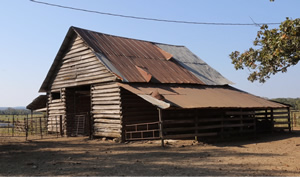Because agriculture is a major theme in the state’s development history, a specific objective of Oklahoma’s state plan is to document agriculture-related resources and nominate them to the National Register. During the SHPO’s annual consultation with the preservation community and the public about priorities for the HPF grant application, the survey of historic barns was identified as a very high priority, and the work began in 2009.
The SHPO designed a five-phase thematic survey project and based each phase on one or two of the seven management regions established in the statewide planning process. Due to staffing level and budget constraints, the Oklahoma SHPO carries out much of its survey work through partnership arrangements, and Oklahoma State University’s Department of Geography entered into cooperative agreements with the SHPO for the historic barns project. The SHPO provided 60% of costs from each of five successive HPF grants, and OSU provided the 40% matching share each year.
The survey design called for recordation of at least ten barns in each of Oklahoma’s seventy-seven counties (including examples of as many barn types as possible). A total of 966 barns were ultimately documented. A Historic Preservation Resource Identification Form (the SHPO’s standard survey form) was completed for and photographs taken of each structure. Results of the survey are maintained in the Oklahoma Landmarks Inventory, available in the SHPO’s office and on its website. The reports provide important individual barn histories and detail the history and geographical patterns of various barn types, functions, and architectural forms. As farming and ranching practices change, many of the barns become obsolete, fall into disrepair, and are often demolished. The survey project and subsequent National Register nominations are essential to preserving this important part of Oklahoma’s heritage. The project also provides important context for resource evaluation during Section 106 consultations.
The historic barns survey continues to attract wide-spread media attention, especially as National Register nominations are processed. For example, Channel 9, Oklahoma City’s CBS affiliate, aired a feature to announce the Acre Family Barn’s listing in the National Register. The Oklahoma Department of Agriculture featured the project and the SHPO’s Oklahoma Centennial Farm and Ranch Program in its 2015 annual report [page 47].
A few barns, well known in the state, such as the Arcadia Round Barn on Route 66, were individually listed in the National Register and included as contributing resources in listings such as the Blue Hawk Peak Ranch (Pawnee Bill Ranch) prior to the thematic survey, to date, six additional barns, identified in the survey or as a result of publicity about it, have been listed:
Acre Family Barn (Blaine County): built c.a. 1916, a one-and-one-half story, medium-sized Transverse-crib barn, located in west central Oklahoma. (nomination not yet on SHPO website)
Bennie Aupperle Dairy Barn: (Kay County): period of significance is 1934-1954, excellent example of a pre-World War II dairy barn, located in north central Oklahoma
James Bounds Barn: (Marshall County): built ca. 1890, an exceptionally rare (only known example in the state), four-crib log barn that remains in excellent condition, located in far southeast part Oklahoma
Oklahoma A&M Dairy Barn: (Payne County): constructed 1948, designed by Paul Harris, located on the campus of Oklahoma State University
James Martin Baggs Log Barn: (Pushmataha County): constructed in 1909, Log Transverse-crib barn, located in rural southeast Oklahoma
Elmer Baker Barn: (Texas County): period of significance is 1906-1955, outstanding example of a Transverse-crib barn, located in central Oklahoma Panhandle
